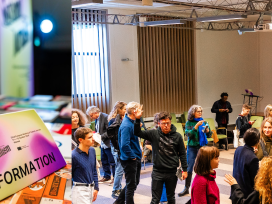Looking at how elements of fascism can emerge spontaneously in contemporary society enables us to see that fascism does not originate from “evil” or “lack of enlightenment”, but rather from the logic of objective historical processes, and from internal pressures and tensions. It is therefore essential to struggle against modern fascism at an objective level: by addressing changes in historical structure and the processes this structure “automatically” generates. Moralistic campaigns, the promotion of tolerance and so on, cannot be effective since they do not take account of historical causes. They merely serve to obscure or distract, and quite often also encourage or even introduce the processes that lead to contemporary fascist practices. In these moralistic campaigns, conducted at a governmental and European level, we can observe the authoritarian element present in current liberal politics. In a democracy, the people should be telling the rulers what to do; now the rulers instruct the people on what they should do, think and feel, and tell them what is good for them.
My broad thesis is that in the last twenty or thirty years two kinds of “fascism” (for want of a better term) have arisen. Each of these types of modern “fascism” was produced by heterogeneous processes which initially did not have much in common. There was nothing in these processes that would inevitably produce “fascism”. But once their effects had crystallized and interconnected, there appeared what we would conditionally call “fascism”.

Two errors of theoretical analysis
At the end of the 1980s and in the early 1990s many of us in Slovenia were shocked to witness mass support for emerging political elements with visibly fascist tendencies. We were so troubled that we failed to consider another feature of this historic event: that these fascist elements had never previously combined in the historical model of fascism. In the early 1990s, we partially distanced ourselves from our own theses, and spoke of “cultural fascism”. The ideological ingredients were very powerful. They included racist and extremist nationalist ideologies, based on the mythology of a canonical national literature. This was the ideological foundation for the political practices that ignited war in Yugoslavia, led to ethnic cleansing, and ultimately also to genocide.
It was hard to grasp, at first, why these ideological and political elements, which were indeed fascist, had not been articulated in the model of historical fascism. Further, we did not recognize that, as early as in 1992, a different type of fascist praxis had emerged in Slovenia. It was characterized by the slogan “Not left, not right, but better” (accompanied by a portrait of the party president and the party symbol). Seeing this campaign slogan, proclaimed by the Liberal Democratic party, I thought immediately of the classic study on French fascism Ni droite, ni gauche (Neither right nor left) – the title which became the slogan for emerging fascist ideology in France. Regardless of the historical analogy, however, we interpreted this slogan incorrectly. The leader of this party was an old apparatchik and its operatives were for the most part careerists from various regimes. This led us to conclude that the party was depoliticizing its discourse, since it did not want people to remember its past. Under this slogan, it won. When, almost twenty years later, the mayor of Ljubljana presented his new party during the 2011 election campaign, he promoted it with similar words: “We will not talk about ideology, rather we will carry out our programme.” (At the time his party did not have a programme.) It is a chilling fact that the speaker quickly became the most popular politician in the country and that he and his party also went on to win the elections.
Two types of fascist political practice
Two historical types of recent fascist political practice can therefore be identified. They arose one after another with a brief interval in between. Their common feature is that they are “anti-political”. Otherwise, they differ in a number of respects.
The first was established at the turn of the decade from the Eighties to the Nineties. We could call it “romantic cultural fascism”. Its basic ideology is nineteenth century nationalism with no liberal dimension. There is also a strong element of racism in Slovenia, predominantly of the Orientalist strain (touching on mythologies about Europe’ s relationship with the Balkans and the identity of “Central Europe”). If this political position gains the opportunity, it organizes ethnic cleansing (through the use of regular military force, through paramilitary violence, or simply by means of administrative measures, as in the case of the erased citizens of Slovenia). It strives to create an authoritative state. In short, it is “anti-political” in the romantic-racist style.
The other practice could be called “realistic technocratic non-politics”. It claims to be free of ideology and to have no interest in politics, but argues rather that it engages in problem-solving, social management, and the application of expert solutions. Its ideology is liberal: freedom, equality, tolerance, multiculturalism. Since it seems to incorporate the assumptions of modern (bourgeois) political systems, it is largely “invisible”. It operates, as it were, at the “zero level” of bourgeois politics. The style is authoritarian, but declaratively “non-populist”: it does not flatter the public, but disdains it. Given the opportunity, this form of politics introduces legislation and regulations which enable discrimination and extreme exploitation (of migrant workers and non-citizens, but also workers with little job security – so-called “independent entrepreneurs” who work through civil law contracts, etc.). The general effect of this form of political practice is still in the process of being established: a quasi-caste society based on a differentiated legal and work status (regular employment, precarious employment, independent entrepreneurs in the position of sub-contractors, the unemployed) and on a segmentation of the labour market.
This begs two questions: Why and how did this type of “anti-politics” emerge at all? And why is “anti-politics” so popular? My hypothesis is that there exist two main structural constellations which enable fascist politics: one provides it with mass support; the other acts to enhance the “expanded reproduction” of fascist political practice. We can address the question of the popularity of and mass support for fascist “anti-politics”, if we examine social-political processes from the grassroots. Equally, we can identify the sources of fascist anti-politics if we look from the top down.
The two structural constellations appeared one after another and enabled the emergence of two types of political practice: first, the constellation which first triggered “romantic cultural fascism” and ensured mass support for fascist practices; second, the constellation which arose soon afterwards, giving rise to “realistic technocratic fascism” and ensuring a steady support for fascist practices that came to be reflected in policies formed by coalitions in the new ruling class.
Why mass support?
The restoration of capitalism has demanded the establishment of a new “class compromise”, or at least passive acquiescence from working people towards the new order and to new forms of exploitation. This is far worse and more brutal than it was in the socialist past. Yugoslav socialist self-management was a fragile “class compromise” based on a mutual blockade formed by bureaucratic-managerial factions and the working class. When the global crisis of the late 1970s and early 1980s extended into Yugoslavia, two foundations of the existing self-management compromise crumbled: job security and the reliability of wages. For the first time in 45 years of socialism there was mass unemployment. Real income fell, and high and accelerating inflation exacerbated the insecurity. Within companies, the system of self-management was not capable of dealing with problems which could be effectively addressed only at the level of the national economy and the federal state as a whole. Workers began to organize themselves outside the self-management mechanism (staging “wildcat strikes”, forming independent unions) and to address the state directly. There was an increasing likelihood of confrontation between working people and the state and party bureaucracy.
By the beginning of the 1980s, possibilities for reforming socialism through self-management mechanisms had dwindled to nothing. In the 1960s “market socialism” had confined workers’ self-management to separate production units, which tended to operate as individual capital and which were socialized ex post on the market. For an individual company it was no longer possible to adequately resist the neo-conservative and neo-liberal offensive undermining national economies. In the 1970s Yugoslavia abandoned “market socialism”. The system inaugurated by the Constitution of 1974 tried to replace the ex post market mechanism by “self-management agreements”, which were intended to socialize production processes ex ante and function as a form of planning “from below”. This system was rigid and caused a hypertrophy of legal regulations, but above all it licensed the creation of monopolies, monopolistic extortion and rents for monopoly owners.
Social self-management in public services (health, education, pensions and social security) functioned better, at least at the outset, since it established “cross ties” between territorial and production units. But during the crisis it could function only as a system of redistribution, not a mechanism for political decision making and the political guidance of society as a whole.
Thus during the crisis, with growing pressure from working people there remained only the state – not a self-managing socialist state, but a state-party bureaucracy organized, since the late 1970s, according to the requirements of the republics, not the federation. From the 1970s, political bureaucracies in the republics gained legitimacy through nationalism, and left the issue of ideological legitimation to the bureaucracies of the ideological state apparatus (the national and nationalistic cultural “elites”), now accepted into the ruling coalition as a junior partner. (Another junior, but incomparably stronger, partner was the economic bureaucracy, the so-called managerial class.)
Faced with the threat of a popular uprising, the state-party and economic bureaucracies repositioned themselves and re-articulated the ruling coalition of political, economic and cultural bureaucracies. Ideological initiatives were left to the nationalistic bureaucracies of the ideological apparatus and political and economic bureaucracies made use of their authority and positions of leadership in the economy to profit from privatization. They utilized the fragmentation of the public (ensured by the erstwhile consumer integration of workers in “market socialism”, and later deepened by the panic over unemployment and poverty) in order to put a stop to the class politicization of working people. In individual federal republics, coalitions of state, economic and cultural bureaucracies abandoned the socialist project, depoliticized the masses by initiating projects for “national states” – and preserved their power by changing the system.
The first type of “anti-politics” with fascist elements – “romantic cultural fascism” – is thus a result of several simultaneous processes: the powerlessness and disintegration of the self-management system under pressure from the global crisis and the global neoliberal offensive; the re-articulation of ruling political, economic, and ideological bureaucracies; and the successful reshaping of a popular uprising into a demand for the authoritarian establishment of a “national state”.
These new “national” states were established under the guise of nineteenth-century ideology – but in fact were states of a new kind, based on globalized capital at a time of (very possibly terminal) crisis within the formerly hegemonic Euro-Atlantic area.
The origins of contemporary neo-fascism
The new post-socialist state performs two main tasks: it competes with other states to attract capital investments, and manages human resources located within its territories. It will obtain capital if it creates a capital friendly environment: low wages, minimal labour rights (or none), weak unions, the absence of political representation for working people, low taxes, low social insurance contributions (or none), and so on. It must also provide adequate education for the population, mobility and flexibility of labour, segmentation of the labour market to prevent class organization, a highly variable legal status for workers permitting the extreme exploitation and disciplining of the labour force, and the exercise of control over the population. States can then function in accordance with their new role, provided they exclude the people from political decision making and are capable of implementing anti-democratic policies to the advantage of capital. Fascist elements fit organically into this pattern, and contribute to its effectiveness.
In this situation a significant shift is also possible: in their own defence the oppressed and exploited can organize spontaneously into identity groups. The basic unit of survival, the household, no longer has a steady and reliable source of income. Members who contribute to the household budget have varied and often irregular incomes, some may be unemployed, many work in the grey economy or are engaged in illegal economic activities. In these circumstances family discipline must be tightened if the household is to survive. All income has to be directed into the family budget, no one can be allowed to skimp on their responsibilities. It is also necessary to tighten control over the behaviour and actions of family members, especially women and children. In intensifying control and discipline all available means come into play: religious ideology, ethnic loyalty, traditional values. The so-called “renewal” of the patriarchal family, the revival of traditional models, “re-traditionalization” – all these are new forms of sociality imposed by contemporary capitalism. Identity construction strengthens ties within the household and at the same time makes it possible to re-establish a support network in an environment, otherwise destroyed by capitalist processes.
A characteristic feature of identity groups is that they are authoritarian on the inside and exclusive on the outside. The spontaneous stand taken by the oppressed or the exploited in defence of their own identity therefore degrades social ties and supports associated processes through which capital can assert its rule.
Once again rulers can link their parasitic strategies to the spontaneous defensive responses of the depoliticized masses. Updated nineteenth century nationalist ideologies, long without any emancipatory power, can be used to shape identity groups that will give effective social support to the modern state. The former national state has been transformed into the identity state. Fascist practices are an intrinsic part of this socio-political construction.







